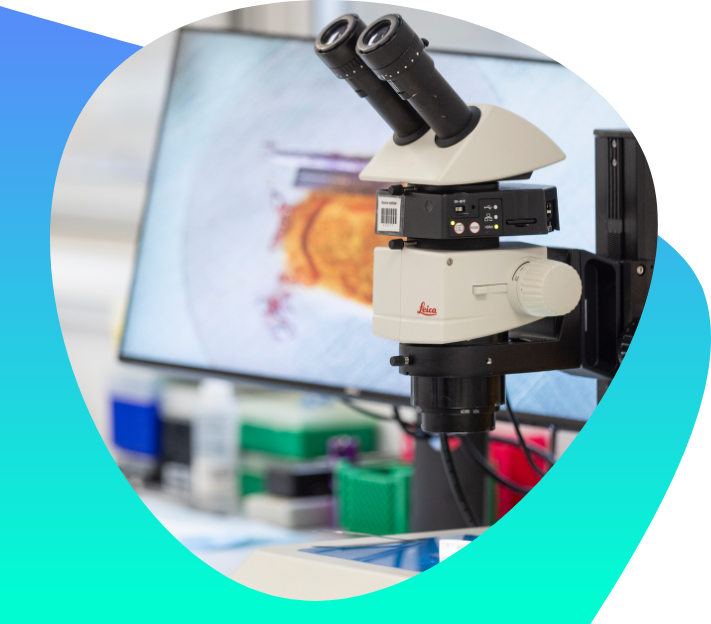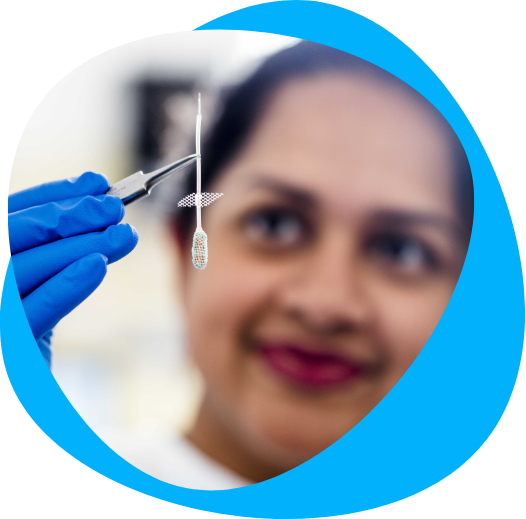Crohn’s
disease
Generalised symptoms can include tiredness, fever, or weight loss [2]
Abdominal pain and diarrhoea are common, sometimes with passage of blood [2]
Up to 50% of people with Crohn’s require surgery within 20 years of diagnosis, due to complications such as [2]:
- Stricture (narrowing) of the bowel causing obstruction (symptoms of obstruction include nausea, vomiting, abdominal bloating and pain, and constipation)
- Abscess (collection of pus)
- Fistula (a narrow tunnel growing between organs)
Perianal disease occurs in up to 42%of people with Crohn’s within 20 years of diagnosis. Fistulas are the most common disease, but also strictures, ulcers, haemorrhoids (piles), fissures (tears), skin tags and rarely cancer can occur [6].
Other organs can also be affected, such as the skin, eyes, and joints [1].
Crohn’s disease appears to be caused by a complex interplay between genetics, environment, gut bacteria, and the immune system [4,7].
Relatives of people with Crohn’s have a higher risk than average of developing the disease [1].
Smoking may double the risk of developing Crohn’s and its complications [8].
Whether diet has a role in inflammation is unclear [1,9].
Crohn’s disease is diagnosed after a thorough history, physical examination, and appropriate tests, as shown in Table 1.
TABLE 1
Commonly used tests
| Stool tests |
|
|---|---|
| Blood tests |
|
| Endoscopy |
|
| Capsule endoscopy |
|
| Imaging tests |
|
Treatment aims to manage flares and maintain remission, with surgery for drug-resistant disease or complications [10].
The Montreal classification system helps doctors to decide on best treatment. This system categorises the disease as to which parts of the gut are inflamed, presence of strictures, whether inflammation has spread to the outer gut wall, and whether perianal disease is present [6].
Generally, medications are the first line of treatment. Medications can range from antibiotics, to anti-inflammatory therapies, to those that suppress the immune system [10]. However, medications can cause side effects.
Surgery is always required for fistulas that have formed between gut and vagina or gut and bladder, and perianal fistulas are treated by drainage and sometimes further surgery.
If someone’s gut disease is severe, such as penetrating the full thickness of the bowel wall or abscesses within the abdomen, or their Crohn’s is not responding to medical treatment then surgery may be considered.
Operations do not always involve bowel resection (removal) of diseased gut, but can include keyhole treatments, and repairs of strictures [6].
Smoking and mental health issues should also be addressed [2,8].
Evidence for dietary manipulation is not strong [1,2,9].
New treatment under development at the Bionics Institute
Bionics Institute researchers are developing an electrical medical device for people with IBD that aims to:
• Improve symptoms
• Prevent recurrence of the disease after surgery and need for a second operation
• Avoid the need for further medications
How does it work?
• A tiny electrode array is attached to the vagus nerve just under the diaphragm
• The vagus nerve connects the brain to the gut and controls natural anti-inflammatory processes in the body
• The vagus nerve is stimulated by the electrode array in response to gut inflammation caused by Crohn’s disease.
• The vagus nerve initiates a natural anti-inflammatory response to reduce the symptoms of Crohn’s disease
• The electrode array is powered by a small battery implanted at hip level.
• The battery only needs to be replaced every 10 years ensuring the device provides a set-and-forget treatment
• The treatment causes fewer side effects than medications
Want to support the future of research like this?
Early-stage research for life-changing devices like this is made possible by donations from our supporters.
Your support today could turn the seed of an idea into a new treatment in the future.
Medical disclaimer
This article contains general information relating to a medical condition. Such information is provided for informational purposes only and does not replace medical advice given by your healthcare professional.
References
1. Feuerstein JD, Cheifetz AS. Crohn Disease: Epidemiology, Diagnosis, and Management. Mayo Clin Proc [Internet]. 2017 Jul 1 [cited 2022 Feb 8];92(7):1088–103. Available from: http://www.mayoclinicproceedings.org/article/S0025619617303130/fulltext
2. Lichtenstein GR, Loftus E V., Isaacs KL, Regueiro MD, Gerson LB, Sands BE. ACG Clinical Guideline: Management of Crohn’s Disease in Adults. Am J Gastroenterol [Internet]. 2018 Apr 1 [cited 2022 Feb 8];113(4):481–517. Available from: https://journals.lww.com/ajg/Fulltext/2018/04000/ACG_Clinical_Guideline__Management_of_Crohn_s.10.aspx
3. Australian Government D of H. Inflammatory Bowel Disease National Action Plan 2019. (CC BY 4.0) [Material adapted] [Internet]. 2019 [cited 2022 Feb 3]. Available from: https://www.health.gov.au/sites/default/files/documents/2019/09/national-strategic-action-plan-for-inflammatory-bowel-disease-inflammatory-bowel-disease-national-action-plan-2019_0.pdf
4. Alatab S, Sepanlou SG, Ikuta K, Vahedi H, Bisignano C, Safiri S, et al. The global, regional, and national burden of inflammatory bowel disease in 195 countries and territories, 1990–2017: a systematic analysis for the Global Burden of Disease Study 2017. Lancet Gastroenterol Hepatol [Internet]. 2020 Jan 1 [cited 2022 Feb 3];5(1):17–30. Available from: http://www.thelancet.com/article/S2468125319303334/fulltext
5. Busingye D, Pollack A, Chidwick K. Prevalence of inflammatory bowel disease in the Australian general practice population: A cross-sectional study. (CC BY 4.0). PLoS One [Internet]. 2021 May 1 [cited 2022 Feb 4];16(5):e0252458. Available from: https://journals.plos.org/plosone/article?id=10.1371/journal.pone.0252458
6. Meima-van Praag EM, Buskens CJ, Hompes R, Bemelman WA. Surgical management of Crohn’s disease: a state of the art review. (CC BY 4.0). Int J Colorectal Dis [Internet]. 2021 Jun 1 [cited 2022 Feb 23];36:1133–45. Available from: https://link.springer.com/article/10.1007/s00384-021-03857-2
7. Loddo I, Romano C. Inflammatory bowel disease: Genetics, epigenetics, and pathogenesis. Front Immunol [Internet]. 2015 [cited 2022 Feb 3];6(NOV). Available from: /labs/pmc/articles/PMC4629465/
8. Berkowitz L, Schultz BM, Salazar GA, Pardo-Roa C, Sebastián VP, Álvarez-Lobos MM, et al. Impact of cigarette smoking on the gastrointestinal tract inflammation: Opposing effects in Crohn’s disease and ulcerative colitis. (CC BY). Front Immunol. 2018 Jan 30;9(JAN):1–10.
9. Bernstein CN, Eliakim A, Fedail S, Fried M, Gearry R, Goh KL, et al. Inflammatory Bowel Disease: Update August 2015. World Gastroenterology Organisation Global Guidelines. 2016. p. 1–36.
10. GESA. Management Overview of IBD [Internet]. 2021 [cited 2022 Feb 4]. p. 1–2. Available from: http://www.gesa.org.au



